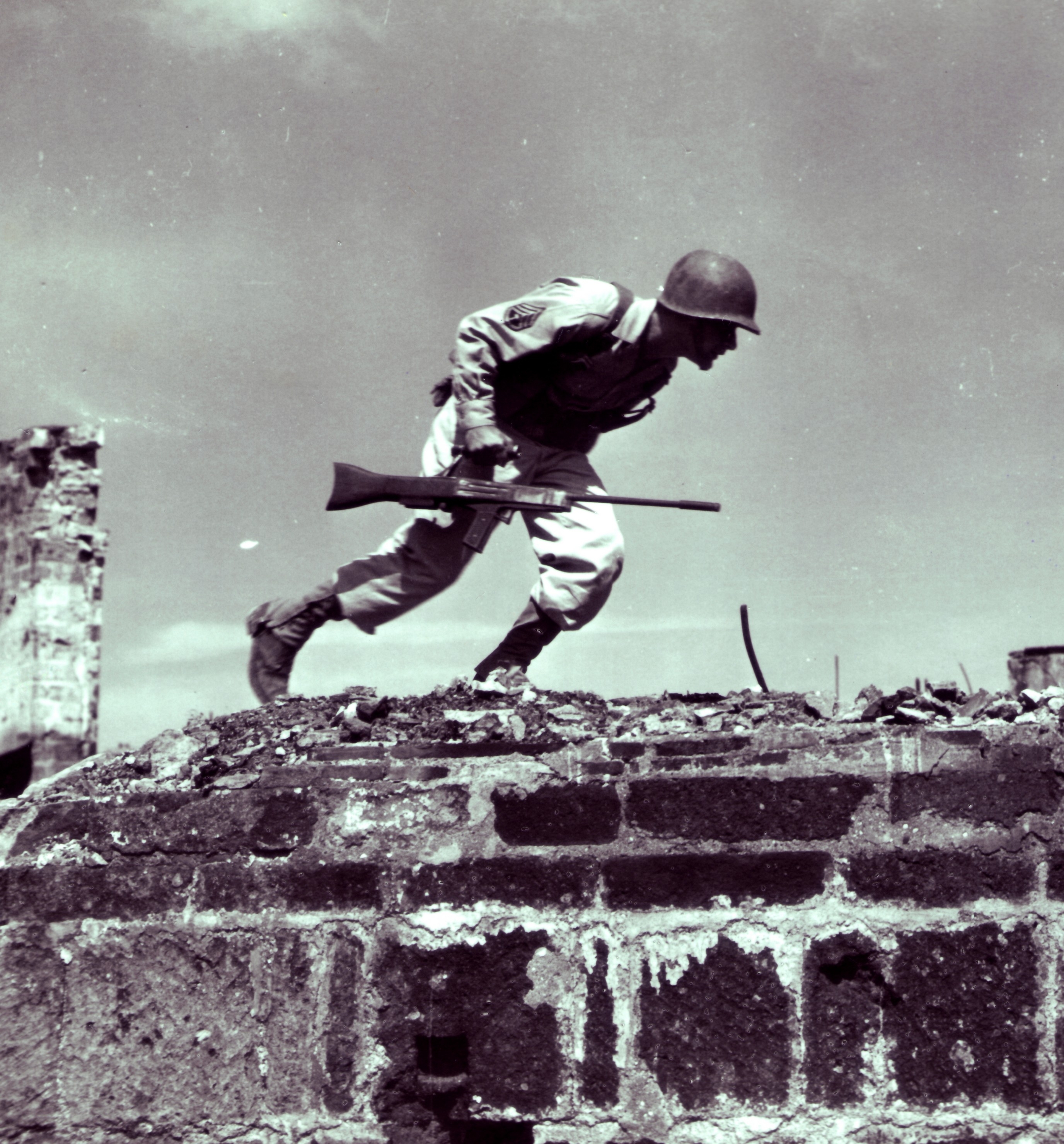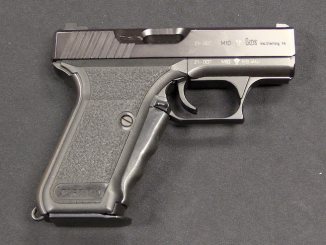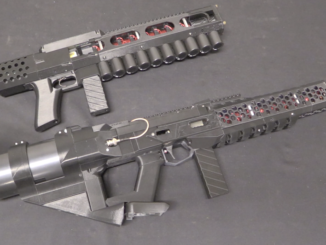The “Tom Thumb” is a tiny .22 rimfire revolver made in Belgium by an unknown shop and imported into the US to be sold by the Daly Arms Company of New York. These are antique guns, probably made in the 1870s or 1880s, chambered for the original black powder .22 rimfire cartridge. There are other similarly sized guns (like the Colt New Line rimfire revolvers), the the use of a ring trigger here is quite unusual. The ring appears to be too small to actually use, and in seeming acknowledge of this, the front face of the ring is textured for grip. Why these revolver didn’t use the much more practical sheath trigger is a mystery…
Related Articles

Prototype
US Model 45A
by Tom Laemlein A couple of years ago, I wrote a short article for Small Arms Review magazine on the strangely futuristic “Model 45A”, which was the subject of a group of photos by a […]

Semiauto pistol
H&K’s Hydrocephalic P7M10 in .40 S&W
Everyone has an off day eventually, and for H&K one of those off days took the form of the P7M10. Introduced in 1991, the M10 was based on the frame and magazine body of the […]

Electromagnetic Weapons
ArcFlash Labs EMG-02 CoilGun: Making SciFi Weapons Into Reality
ArcFlash Labs has come out with a new coil gun design that takes the best elements of their underpowered EMG-01 and their overly bulky GR-1 Anvil and melded them into a much handier EMG-02. This […]

What is the lever above the trigger?
That’s the spring that operates the cylinder bolt.
cheers
eon
It is a half cock safety inserting a steel lateral rod under the hammer when it is slightly rolled back…
Thanks
A sheathe trigger really only works on a single-action searage, so there would have been no practical way to put a sheathe trigger on this revolver.
That leaves a full trigger guard or a folding trigger as the alternatives. The full trigger guard would have been a more sensible choice than a folding trigger.(Less moving parts exposed to pocket lint, etc.)
As to the ring’s size, everything about this revolver says “Lady’s Gun” to me. The kind that ladies in the 1870s to early 1900s carried in place of the single-shot muzzleloading “muff pistols” of the 1840s, before the advent of the .25 ACP cartridge and the “Baby Browning” automatic.
While a man might not be able to get his forefinger through that ring, a young lady with “delicate hands” probably would have no problem.
As to how it might have been used, this;
-“The Adventure of Charles Augustus Milverton”, by Sir Arthur Conan Doyle, The Strand Magazine, April 1904.
Point-blank range, rapid fire.
As the old saying goes, Hell hath no fury…..
clear ether
eon
Lovin’ it. Your surmise re the revolver’s target market is spot on
“(…)made in Belgium by an unknown shop(…)”
I did search inside https://archive.org/details/AlfaWaffenkatalog1911 and found externally similar weapon at page 111, number is 243, marketing name Cycle description
brightly polished, round
barrel, trigger ring, wal-
nut grip.
caliber is 5 mm (rim-fire), price 6.40 Mark
I do not know if their makers was related of Tom Thumb, but it shows weapons of similar style were sold in Europe as late as 1911.
“(…)use of a ring trigger here is quite unusual(…)”
Whilst idea of using ring trigger at revolver might be alien to U.S. revolver manufacturers of 19th century, such trigger were sometimes used at European pin-fire revolvers of 19th century. Examples from past auctions:
https://www.icollector.com/RING-TRIGGER-PINFIRE-REVOLVER_i987749
https://www.enochsantiquearms.com/store/p157/7mm_Single_Action_Pinfire_Revolver_With_Ring_Trigger._SOLD..html
https://www.gunsinternational.com/guns-for-sale-online/revolvers/antique-revolvers—cartridge/beautiful—unique-antique-mariette-brevete-pinfire-double-action-revolver——–ring-trigger—serial-number-6—.cfm?gun_id=101432347
I can see what might have been thought of as advantages of ring triggers. Maybe a bit more comfortable leverage for stiffer hammer springs in double actions. Maybe thought to be less likely for the trigger to catch on clothing and misfire. I am wondering if these smaller earlier pistols were always intended to be carried in a pocket.
1. the ring might not be intended for the finger to be inserted, Ian shows that his index finger COULD pull the trigger with just the pad in the gap.
2. a plain trigger on this piece would be so close to the grip it couldn’t be pulled, the ring puts a pulling surface far enough forward.
Of cours, 2 begs the question: ‘why not cut off the back of the ring.’
Read eon’s comment about this being for ladies. This would make sense. The checkered front of the ring could be for pulling with two fingers. Just how many pounds of pull does the trigger require? Maybe some women would have needed the extra leverage. Morphy needs to find their female employee with the smallest hands to hold the pistol. Or maybe somebody’s teenage daughter as a test subject.
Back in those pre-SWCPL/IPSC days, a “nice young lady” would likely have had both hands on the revolver, in a more-or-less isosceles stance, the gun about level with the top of her corset, and with both forefingers pulling the trigger; one through the ring, the other on its front.
Victorian Combat Shooting 102, Ladies’ Section.
clear ether
eon
Considering that this clearly is not military weapon, response might be very simple: fashion or to make your product distinct from another tiny revolvers of 1880s.
Wonderful quirky little side piece for deep cover backup to more reasonable larger piece of carry ordinance. Still not much better than the Apache combination from the Parisian street gangs multi weapon. Simply has a more defined role in owners life.
I figured if anybody knew more about the odd trigger, it would be Jonathan Ferguson. Here is the texts of the email I sent him and his response.
Hello Jonathan,
Did you see the recent Forgotten Weapons episode on the Daly “Tom Thumb” revolver? (https://www.forgottenweapons.com/daly-arms-tom-thumb-a-tiny-ring-trigger-revolver/?replytocom=4511061#respond)
The odd ring trigger is confusing people. Why the spur on the front of the ring? The commentators have felt that the design was intended for ladies and that the spur allowed for a two-hand hold on the pistol, with a two-fore-finger pulling of the trigger.
Have you run across any period documentation that would support the idea that this was a standard grip technique for women in the era?
Thank you for any comments on the matter.
—————————
Hi Bart,
Possibly – and the owner could definitely use it that way to their advantage, but as far as design intent goes, two-hand grips were basically unknown at that time. I’ve seen one period depiction of a lady at the shooting range holding as percussion target pistol with two hands but that’s art showing a “fish out of water” situation. I haven’t seen or read of any serious user (and that includes adverts aimed at/depicting women defending themselves) holding with both hands, much less pulling the trigger with both fingers. We do find two-finger triggers e.g. the Tranter, but there it’s to facilitate a special mechanism – or “walking” triggers for different firing rates etc. If you needed more finger strength, you pulled with the middle finger – we have a flintlock-era depiction of that.
My guess would be that it’s there to accommodate different finger sizes and lengths (as Ian notes, the typical person of the period would have much smaller hands and fingers than today – plus there are adolescents to consider). Basically, ring trigger for (many) women, knurled and spurred front for (most) men (and women with bigger fingers).
As Ian says, you won’t find any hard evidence on this – whoever made this wasn’t big enough to have made any adverts depicting its use, and instruction manuals weren’t a thing.
Hope that helps,
Jonathan
When this came out, most Americans had heard of General Tom Thumb- https://en.wikipedia.org/wiki/General_Tom_Thumb